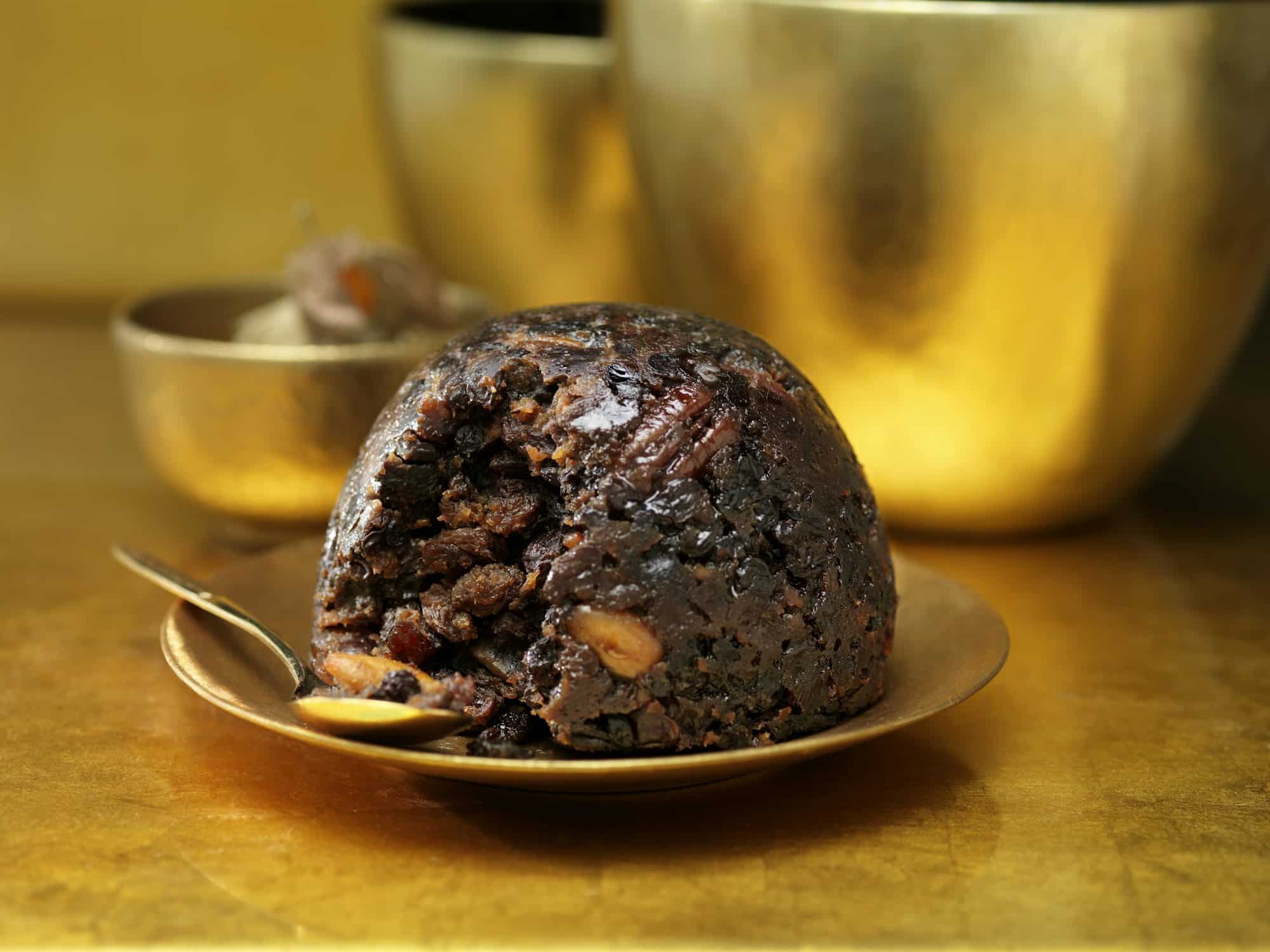Murray’s Steamed Fruit Pudding is a beloved Canadian dessert combining British tradition and local flair. We’ll show you how to make this rich, moist pudding using simple ingredients like flour, breadcrumbs, butter, or suet. Mix 2 cups flour, 1½ cups breadcrumbs, 1 cup butter, ¾ cup sugar, and 2 tablespoons golden syrup with an egg and milk until you get a thick batter. Steam it for 3 hours in a covered basin – or try the quick 45-minute Instant Pot method! Serve warm with custard or cream, and don’t forget those fresh berries on top. There’s so much more to discover about this comforting classic.
In Johanna Burkhard’s “What’s Cooking” column, which I clipped from The Montreal Star’s food section (November 2, 1994), she answers a reader’s request to get the iconic recipes for Murray’s Steamed Fruit Pudding and accompanying Vanilla Sauce.

Key Highlights
- Murray’s Steamed Fruit Pudding is a Canadian dessert that combines with British tradition.
- The pudding requires flour, breadcrumbs, suet or butter, sugar, and dried fruits, steamed in a 4-liter pudding basin.
- Preparation involves mixing dry and wet ingredients to a thick batter consistency, then sealing with parchment paper and foil.
- Traditional steaming takes 3-4 hours on the stovetop, while pressure cooking reduces time to 45 minutes plus natural release.
- It is best served warm with vanilla custard sauce or cream and can be stored when cooled by wrapping it in parchment and foil.
Ever since that article was published, I have regularly made the recipe. Even before the restaurant closed its remaining location in 2009, I made it for friends and family.
Exclusive Legacy Must Have! Murray’s Restaurants Mug
Take a sip in time with the exclusive Murray’s Restaurants Mug, a charming piece of Canadian history. This 11-oz ceramic mug is more than just a vessel for your coffee—it’s a tribute to the warmth and unforgettable flavors of Murray’s, the beloved institution that once graced Montreal, Toronto, Ottawa, and Sudbury. With its colorful
Since the restaurant closed, many on social media have searched for the recipe for Steamed Fruit Pudding on their menu from Canadian Thanksgiving Day (the second Monday in October) until Mother’s Day (the second Sunday in May), and I have gladly shared it.


The History Behind Murray’s Pudding
While records of Murray’s Restaurants date back to their Canadian origins, their steamed fruit pudding became a beloved staple that captured both British tradition and Canadian innovation. We can trace this delightful dessert’s journey through their Montreal, Toronto, Ottawa, and Sudbury restaurants, which warmed countless families’ hearts.
My version of the recipe evolved as I adapted it to my tastes and ingredients. Isn’t it amazing how a simple dessert can bring people together?
I have made the original beef suet version and used butter instead, and I have recently tried vegetable suet a few times to determine which I prefer. I couldn’t detect any difference in taste or texture among the three.
Recently, I made a version using small individual pudding molds to try and emulate the look of how it was served at Murray’s. I used Atora vegetable suet from Great Britain and made it in the Instant Pot. I steamed it at high pressure for 45 minutes, and it came out great.
I filmed the process and will add a video with a separate article on the Instant Pot / Pressure Cooker method.
This is how the final product turned out:

Essential Ingredients and Equipment
The heart of Murray’s beloved steamed fruit pudding lies in its carefully chosen ingredients and proper equipment.
Let’s gather everything we’ll need to recreate this Canadian classic!
We’ll start with all-purpose flour, fine breadcrumbs, and beef or vegetable suet or butter (your choice!).
We’ll also need granulated sugar, baking soda, and that wonderful mince meat that gives our pudding its signature taste and texture.
Now, for the equipment, we need a 4-liter pudding basin, which is essential for proper steaming.
We’ll also use parchment paper and aluminum foil to create a watertight seal.
Got some baker’s twine? We’ll use it to make a handle for easy lifting.
A medium saucepan with a steamer insert works perfectly, but don’t worry if you don’t have one – an upturned plate works too!
Shall we get started?
Making the Pudding Base
Once we’ve gathered our ingredients, creating the pudding base becomes an essential first step.
Want to know a little secret? This is where the magic happens! Slowly add the wet ingredients to our dry mixture, stirring gently until everything comes together.
When I first saw the recipe in 1994, it was already on the menu that year, so I could more easily compare mine using this exact recipe versus what I could order in the restaurant. Surprisingly, the taste and texture were indistinguishable from how it was served at Murray’s.
Each portion seems to have been individually steamed in the restaurant, while the at-home version is cooked together in a single mold. I have purchased individual molds and will share how that turned out.
Before attempting the recipe the first time, I was more than intimidated. I had never tried any pudding steaming. Later in life, I learned that “pudding” is the British word for most desserts. Steamed Fruit Pudding is more of a warm steamed cake with a sauce poured over it than what we think of as pudding here in North America.
Mixing the ingredients was the most challenging part of the entire recipe, as integrating them is essential for the proper texture and presentation.
The consistency should be like a muffin batter – not too wet or dry. Does yours look right? If it seems a bit stiff, add another splash of milk.
Steaming Using the Instant Pot
We’ve got a fantastic time-saving option for those with an Instant Pot or other brand electric pressure cooker. Place the covered pudding basin on the pot’s trivet, add 2 cups of hot water, and seal the lid.
Set to high pressure for 45 minutes, followed by a natural release. Isn’t it amazing how pressure cooking cuts down the time?
Whichever method you choose, you’ll know your pudding is ready when it’s firm to the touch and when a skewer inserted comes out clean.
Want to make it ahead? The pudding keeps wonderfully for up to two weeks when appropriately wrapped!
If you are thinking of making this and other steamed puddings, we have created a roundup of the 8 Best Dessert Pudding Steamers to Satisfy Your Sweet Tooth
As the article states, Murray’s used the mincemeat made by Rose and Laflamme Ltee; however, the company is no longer in business.
Most of the year, I usually find Robertson’s in my local grocery store. This Steamed Fruit Pudding recipe can easily be doubled to serve a larger crowd. If you double it, use an eight-cup 2 L) mold or bowl and increase the steaming time by about one hour.
Serving and Storage Tips
Murray’s Steamed Fruit pudding is fresh from steaming and deserves proper serving and storage to maintain its delightful flavors. We’ll show you how to make the most of this classic dessert, just as we’ve done countless times at our family gatherings!
Here are our top serving suggestions that’ll make your pudding extra special:
- Serve warm with a generous pour of hot custard or cream, Murray’s served it with their Vanilla Custard Sauce. Here is their recipe.
- Garnish with fresh berries and a sprinkle of powdered sugar
- Add a dollop of whipped cream and a drizzle of golden syrup
Want to save some for later? Let’s talk storage! Cool your pudding completely before wrapping it tightly in parchment paper, then aluminum foil. It’ll keep beautifully in a cool, dark place for up to 2 weeks.
If you’re planning to store it longer, pop it in the fridge for up to a month.
When you’re ready to enjoy your stored pudding, why not steam it again for about 30 minutes? This brings back that wonderful fresh-from-the-oven warmth.
Remember to check the water level every 10 minutes while reheating – we don’t want your pudding drying out!
Steamed Fruit Pudding Frequently Asked Questions
How Do I Adjust Cooking Time for High-Altitude Locations?
We’ll need to increase our steaming time by about 10% at high altitudes for every 1,000 feet above sea level. Let’s keep the water at a more vigorous boil to maintain a consistent temperature.
Why Does My Pudding Turn Out Darker Than Murray’s Original Version?
We often find darker puddings result from the caramelization of sugars during longer cooking times or higher heat. Let’s try reducing our cooking temperature slightly and checking that we’re using lighter-colored golden syrup for better color matching.
Can I Use Silicone Molds Instead of Traditional Pudding Basins?
We’d recommend avoiding silicone molds since they don’t conduct heat as effectively as traditional basins. You’ll get better results with metal or ceramic basins that maintain consistent temperatures and create that perfect steamed texture.
Is There a Gluten-Free Variation of Murray’s Steamed Fruit Pudding?
We can make a gluten-free version! Let’s replace regular flour with a blend of rice flour and almond flour and use gluten-free breadcrumbs. You’ll still get that wonderful texture everyone loves.
The recipe
Murray’s Steamed Fruit Pudding (Traditional Method)
Ingredients
- 75 ml 2% milk may be fat free or non-dairy
- 1 large egg
- 250 ml Mincemeat I use Robertson’s, but I have used other brands when Robertson’s was not available
- 125 ml fine bread crumbs I use Kikkoman Panko
- 75 ml all-purpose flour I use unbleached wheat or oat flour
- 50 ml granulated sugar
- ½ tsp baking soda
- 1 pinch salt
- 50 ml Atora Vegetable Shredded Suet you may use butter or beef suet in the same quantity
Equipment
- 1 Pudding Mould or heat-proof bowl such as Pyrex
- 1 string to attach the foil to the bowl
- 1 Aluminum Foil to cover the pudding mould while steaming
- 1 Parchment paper to place in between the pudding and the foil
Method
- In a bowl, whisk together milk and stir in mincemeat until evenly blended250 ml Mincemeat
- In another bowl, combine bread crumbs, flour, sugar, baking soda and salt125 ml fine bread crumbs
- Add the suet, or cut in the butter using a pastry blender or two knives to make fine crumbs50 ml Atora Vegetable Shredded Suet
- Stir in the mincemeat mixture until combined250 ml Mincemeat
- Pour into a well-greased 1.5 l pudding mould or heat-proof bowl
- Pour in boiling water to reach two-thirds up
- Take a large sheet of aluminum foil and a piece of parchment and cut them large enough to cover the bowl fully with some overhang. Place the parchment (I spray it with cooking spray on both sides to avoid sticking) under the foil and press the foil around the sides of the bowl
- Tie a string around the foil to reduce the moisture getting into the bowl. Leave no more than about two inches of overhang of foil and parchment
- I use a pasta pot that has a removable strainer that I can use to extract the bowl when the pudding is fully steamed. You can use string, silicone grabbers or a foil sling
- Cover and steam for about 2.25 hours, adding water (check every 20-25 minutes) to maintain the level or until the tester comes out clean
- When ready, cut the string around the bowl. Wrap well and store in the refrigerator (pudding can be made ahead and frozen)
Nutrition
Video
Notes
Tried this recipe?
Let us know how it was!Here are some pudding steaming tips from Gemma’s Bigger Bolder Baking (one of my go-to recipe sources)
Read our recommendations for Pudding Steamers.
What is Suet Pudding?
Suet pudding is a beloved traditional British dessert that has been enjoyed for generations. Made with suet, animal fat, and flour, this pudding can be filled with various sweet or savory ingredients, making it a versatile and comforting dish. Whether you opt for a rich golden syrup filling or a hearty meat mixture, suet pudding is sure to satisfy.
Atora suet has a rich history in British cuisine, dating back to 1893. It is renowned for its role in making traditional British dishes, particularly suet dumplings, which evoke a sense of nostalgia and childhood memories. Atora suet is convenient and versatile, used in meat and vegetarian recipes, making it a staple in many households.
The magic of suet pudding lies in its unique texture and flavor. The suet, which can be either beef or vegetable-based, melts during cooking, creating a moist and tender crumb that is simply irresistible. This dessert can be prepared in several ways, including steaming, boiling, or microwaving, making it an easy and adaptable option for any home cook. So, whether you’re looking to indulge in a sweet treat or a savory dish, suet pudding is a delightful choice that brings a touch of British tradition to your table.
The Role of Suet in Pudding Recipes
Suet is the unsung hero in many traditional British pudding recipes, influencing the perfect texture and flavor. In suet pudding and Christmas pudding, suet’s high melting point allows it to retain its shape and texture during cooking, resulting in a moist and tender crumb that is hard to replicate with other fats.
Two main types of suet are used in pudding recipes: beef suet and vegetable suet. Beef suet, derived from the fat around cattle kidneys, imparts a rich and savory flavor to the pudding. Vegetable suet, such as the Atora brand, offers a lighter and more neutral taste, making it a popular choice for those looking to reduce their intake of animal fats.
Beyond flavor, suet also helps to bind the ingredients together, ensuring a cohesive and smooth texture. This binding property is essential for the pudding’s structure, allowing it to hold shape and deliver that classic, comforting bite. Whether you’re making a traditional Christmas pudding or experimenting with new suet recipes, understanding the role of suet can help you achieve the perfect result every time.
Golden Syrup in Suet Pudding
Golden syrup is a quintessential ingredient in many suet pudding recipes, adding a sweet and sticky dimension to this classic dessert. Lyles golden syrup, a well-known and trusted brand, is often the go-to choice for many home cooks. Incorporating golden syrup into suet pudding is both simple and transformative.
To create a golden syrup suet pudding, you start by pouring the syrup into the bottom of your pudding basin or bowl. The suet mixture is then added on top, and as the pudding steams, the golden syrup infuses into the suet, creating a delightful blend of sweet and savory flavors. The result is a rich, moist, and utterly satisfying syrup suet pudding.
This classic British dessert is often served with hot custard, which complements the sweetness of the golden syrup and adds an extra layer of comfort. Whether you enjoy it as a festive treat or a cozy dessert on a chilly evening, golden syrup suet pudding is a timeless favorite that never displeases.
To Sum it Up
We’ve loved sharing this treasured Murray’s recipe with you! After mastering these steaming techniques and trying our tested ingredient combinations, you’ll have a pudding that rivals the restaurant’s original. Keep your steaming water at a gentle simmer, and always check with a skewer before removing. Store leftovers wrapped tightly in the fridge – though we doubt you’ll have any! Happy steaming, and enjoy this taste of Canadian comfort food history.















